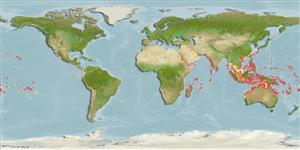>
Gobiiformes (Gobies) >
Gobiidae (Gobies) > Gobionellinae
Etymology: Gnatholepis: Greek, gnathos = jaw + Greek,lepis = scale (Ref. 45335); cauerensis: Named for the southern location of the islands in southeastern Oceania where the species is found..
More on author: Bleeker.
Environment: milieu / climate zone / depth range / distribution range
ນິເວດວິທະຍາ
ສັດທະເລ; ນ້ຳກ່ອຍ ກ່ຽວກັນຫີນ; ລະດັບຄວາມເລິກ 2 - 50 m (Ref. 90102), usually 2 - 20 m (Ref. 27115). Tropical; 30°N - 28°S
Indo-Pacific: widespread from South Africa to Pitcairn I.; in the Pacific north to Miyake-jima, Japan, south to Sydney Harbour, Australia; in the Indian Ocean north to Djibouti (Gulf of Tadjourah) and south to Aliwal Shoal, Kwa-Zulu Natal.
ຂະໜາດ / ນ້ຳໜັກ / Age
Maturity: Lm ? range ? - ? cm
Max length : 6.0 cm SL ຕົວຜູ້/ບໍ່ມີເພດ; (Ref. 48637)
ຄີ (ໜາມ)ແຂງຢູ່ຫຼັງປາ (ທັງໝົດ) : 7; ຄີຫຼັງຂອງປາ (ຄີອ່ອນ) (ທັງໝົດ) : 11; ຄີ(ໜາມ) ແຂງຢູ່ຄີກົ້ນປາ
ກຸ່ມປາກະດູກແຂງ
ຄວາມຖີ່ຂອງກຸ່ມຖ່າຍທອດພັນ
ປາທີ່ມີການເຄື່ອນຍ້າຍຈາກທະເລໄປຫານ້ຳຈືດ ແລະນ້ຳຈືດຫາທະເລ
ປາທີ່ມີການເຄື່ອນຍ້າຍຈາກທະເລແລະໄປໄຂ່ຢູ່ນ້ຳຈືດ
ຄີກົ້ນຂອງປາ
ສັດທີ່ມີກະດູກສັນຫັຼງ
ການຖ່າຍທອດທາງກຳມະພັນຈາກພໍ່ແມ່ຫາລູກ: 1; ຄີກົ້ນຂອງປາ: 11. Distinguished by the following characteristics: moderate-sized (up to 56 mm SL) with wide range in live colour pattern; ctenoid body scales usually reaching rear corner of opercle, occasionally ctenoid scales reaching to above rear preopercular margin; nape midline scales always cycloid, distinct flap present at end of lower lip; when alive, colour variable: body translucent white with five to seven rows of small variably coloured (dull orange, brown, red-brown to blackish) spots and/or thin lines and about six indistinct diffuse orange-brown to purple-brown blotches along midside; narrow vertical black mark on top of each eye, marks may join each other across interorbital space, and narrow black vertical line crossing cheek below eye; small dark mark of variable shape (often W-shaped) above pectoral fin base, with small yellow spot in centre; second dorsal and anal fin rays usually I,11; pectoral rays 12-18, modally 16; lateral scales 24-30, modally 27; 7-12 predorsal scales (modally 9) (Ref. 92171).
A common species that occurs in sheltered sandy areas from reef flats to seaward reefs; over sandy bottoms near pieces of rubble, rock, or coral (live or dead) (Ref. 9710, 48637, 92171). Solitary or in small groups (Ref. 90102). Feeds on algae, detritus and small benthic invertebrates (Ref. 89972).
Life cycle and mating behavior
Maturities | ການສືບພັນ | Spawnings | Egg(s) | Fecundities | ຕົວອ່ອນ
Larson, H.K. and D.J. Buckle, 2012. A revision of the goby genus Gnatholepis Bleeker (Teleostei, Gobiidae, Gobionellinae), with description of a new species. Zootaxa 3529:1-69. (Ref. 92171)
IUCN Red List Status (Ref. 130435)
Threat to humans
Harmless
Human uses
ການປະມົງ: ເປັນສີນຄ້າ; ຕູ້ປາ: ເປັນສີນຄ້າ
ເຄື່ອງມື
Special reports
Download XML
ແຫຼ່ງອີນເຕີເນັດ
Estimates based on models
Preferred temperature (Ref.
123201): 24.7 - 28.9, mean 27.6 °C (based on 774 cells).
Phylogenetic diversity index (Ref.
82804): PD
50 = 0.5010 [Uniqueness, from 0.5 = low to 2.0 = high].
Bayesian length-weight: a=0.00977 (0.00442 - 0.02163), b=3.05 (2.86 - 3.24), in cm total length, based on LWR estimates for this (Sub)family-body shape (Ref.
93245).
ຊັ້ນເຂດຮ້ອນ (Ref.
69278): 2.3 ±0.0 se; based on diet studies.
ຄວາມຢືດຢຸ່ນ (Ref.
120179): ສູງ, ປະຊາກອນຕຳ່ສຸດທີ່ໃຊ້ເວລາສອງໜ້ອຍກວ່າ 15 ເດືອນ (Preliminary K or Fecundity.).
Fishing Vulnerability (Ref.
59153): Low vulnerability (10 of 100).
Nutrients (Ref.
124155): Calcium = 173 [83, 398] mg/100g; Iron = 1.01 [0.47, 1.99] mg/100g; Protein = 18.2 [16.2, 19.9] %; Omega3 = 0.164 [0.069, 0.322] g/100g; Selenium = 23.8 [11.4, 62.9] μg/100g; VitaminA = 122 [29, 448] μg/100g; Zinc = 3.25 [2.10, 4.97] mg/100g (wet weight);
